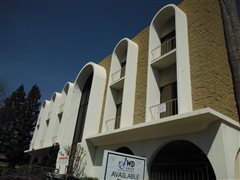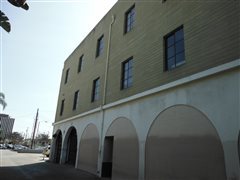
Website: http://www.Coastalinspections.org
Email: reza@coastalinspections.org
Phone: (949) 444-8033
Inspector's phone: (949) 291-7611
Monarch Beach, California
Inspector: Reza Limonadi AIA


Summary
| Client(s): |
Office Building |
| Property address: |
456 Union Street
My Town, California |
| Inspection date: |
Saturday, March 29, 2014 |
This report published on Tuesday, April 29, 2014 9:07:36 AM PDT
This report is the exclusive property of Coastal Inspections and the client(s) listed in the report title. Use of this report by any unauthorized persons is prohibited.
Concerns are shown and sorted according to these types:
 | Safety | Poses a risk of injury or death |
 | Repair/Replace | Recommend repairing or replacing |
 | Repair/Maintain | Recommend repair and/or maintenance |
 | Maintain | Recommend ongoing maintenance |
 | Evaluate | Recommend evaluation by a specialist |
 | Monitor | Recommend monitoring in the future |
 | Serviceable | Item or component is in serviceable condition |
 | Comment | For your information |
General information
1


- Structures built prior to 1979 may contain lead-based paint and/or asbestos in various building materials such as insulation, air ducts, siding, and/or floor and ceiling tiles. Both lead and asbestos are known health hazards. Evaluating for the presence of lead and/or asbestos is not included in this inspection. The client(s) should consult with specialists as necessary, such as industrial hygienists, professional labs and/or abatement contractors for this type of evaluation. For information on lead, asbestos and other hazardous materials in homes, visit these websites:
2

- This structure is in an overall good condition with no deferred maintenance issues or concerns, and is in a good overall structural condition, with no signs of settlement or stress cracks visible, except as noted in this report.
Exterior
3



- One or more trip hazards were found in sidewalk and/or patio sections due to cracks, settlement and/or heaving. A qualified contractor should evaluate and repair or replace sidewalk and/or patio sections as necessary to eliminate trip hazards.
4


- Gaps larger than four inches were found in one or more guardrails. This is a safety hazard, especially for small children. Modify the railing as necessary so gaps in guardrails do not exceed four inches.
5


- Cracks, deterioration and/or damage were found in exterior finish areas of this structure. Some cracks indicate structural movement. Evaluate and make repairs as necessary.
6

- One or more downspouts have no extensions, or have extensions that are ineffective. This can result in water accumulating around the structure's foundation, or in basements and crawl spaces if they exist. Accumulated water is a conducive condition to wood destroying insects and organisms, and may also cause the foundation to settle and possibly fail over time. Repairs should be made as necessary, such as installing or repositioning splash blocks, or installing and/or repairing tie-ins to underground drain lines, so rain water is carried at least several feet away from the structure to soil that slopes down and away from the structure.
7

- There are signs of dry rot on the exterior of this structure. Evaluate, repair or replace as needed.
8

- Gaps exist at openings around the exterior, such as those where outside faucets, refrigerant lines, and/or gas supply pipes penetrate the exterior. Gaps should be sealed as necessary to prevent moisture intrusion and entry by vermin and insects.
10

- This structure's exterior components are in good overall condition with no signs of settlement or major maintenance concerns.
Roof
12



- Stains are found on the flat roof. It is a sign of ponding and an ineffective roof slope. Monitor, evaluate and repair if necessary to prevent prolonged standing water.
15


- Roof is in serviceable condition, but it is patched and repaired in portions. Monitor as necessary and replace if needed to avoid damage to the structure.
Garage
17



- One or more garage electric receptacles appear to have no ground fault circuit interrupter (GFCI) protection. This is a safety hazard due to the risk of shock and fire. Garage is a fire rated area due to the storage of automobiles and gasoline, and all outlets in the garage should be on a ground fault circuit interrupter (GFCI) protection. A qualified electrician should evaluate to determine if GFCI protection exists, and if not, repairs should be made so that all garage receptacles, except for one for use with a refrigerator or freezer, have GFCI protection. For example, install GFCI receptacles or circuit breaker(s) as needed.
18


- Weatherstrip around or at the bottom of the garage doors are missing. It should be installed where missing and as necessary to prevent vehicle fumes from entering office spaces.
19


- There are water stains on the garage ceiling surfaces indicating a past or ongoing water intrusion and possible damage. All stains are dry currently, and the client should evaluate and repair as necessary.
20


- There are cracks in garage's concrete slab. These cracks should be further evaluated structurally and for water tightness. Recommend sealing all cracks to prevent entry of moisture and to prevent further damage.
23

- This garage is in a good overall condition with no display of settlement and other related structural issues.
Plenum Space
24



- Ceiling surfaces in the plenum area of this structure have "popcorn" textured acoustical surfaces possibly installed prior to 1979. This material may contain asbestos, which is a known carcinogen and poses a health hazard. Laws were passed in the United States in 1978 prohibiting use of asbestos in residential structures, but stocks of existing materials have been known to be used for some time thereafter. The client(s) may wish to have this ceiling material tested by a qualified lab to determine if it does contain asbestos.
In most cases, when the material is intact and in good condition, keeping it encapsulated with paint and not disturbing it may reduce or effectively eliminate the health hazard. If the client wishes to remove the material, or plans to disturb it through remodeling, they should have it tested by a qualified lab and/or consult with a qualified industrial hygienist or asbestos abatement specialist. For more information, visit:
http://www.cpsc.gov/CPSCPUB/PUBS/453.html
25


- There are water stains found on the ceiling surfaces on the interior of this structure. This indicates an ongoing water intrusion and penetration. Source of the water stains should be located to stop the ongoing damage and repair as necessary.
26


- Evaluate stains on the drop ceiling surfaces on the interior of this structure for water intrusion and possible further damage, and replace all stained and broken tiles as necessary.
Electric service
28



- Electrical panel boxes in this structure are in serviceable condition, but the main panel box could not be evaluated to to locked doors to these equipment. Evaluate as necessary.
29

- The electrical sub panel boxes are in serviceable condition having needed components, and are adequate for their use.
Water heater
30


- The water heater does not have seismic straps or struts installed. This is a potential safety hazard since movement can cause leaks in the gas supply lines or damage wiring. Leaks may also occur in water supply pipes. A qualified contractor should install seismic straps or struts as necessary and as per standard building practices.
32

- Water heater seemed to be in serviceable condition, providing hot water when inspected.
Heating and cooling
33


- The heating and air conditioning system functioned when tested, circulating air through the offices, however the system did not change the temperature during the operation in either cooling or heating mode. Evaluate, repair or replace as necessary for a proper operation.
34


- Few heating and cooling controls did not function when tested and did not turn on the heat pump system. Evaluate, repair or replace as necessary for a proper operation.
35


- One roof top heater did not turn on when tested. Evaluate it's use and repair as necessary for a proper operation.
Plumbing System
37

- There seems to be an adequate water pressure regulator installed on the main water line entering this structure.
38

- Adequate water pressure is supplied to this structure @ 40 Psi
Bathrooms
39



- One or more electric receptacles that serve countertop surfaces within six feet of a sink appear to have no ground fault circuit interrupter (GFCI) protection. This is a safety hazard due to the risk of shock and fire. A qualified electrician should evaluate to determine if GFCI protection exists, and if not, repairs should be made so that all receptacles that serve countertop surfaces within six feet of sinks have GFCI protection. For example, install GFCI receptacles or circuit breaker(s) as needed.
40


- Few faucets leak by handle or at its base when turned on. A qualified plumber should evaluate and repair as necessary.
41


- One toilet and one urinal did not flush when tested. Evaluate, repair or replace as necessary.
42

- One or more toilet bowls are cracked or broken. A qualified plumber should replace the toilet(s) or bowl(s) as necessary.
43

- One toilet is loose. Adhere all toilets to the finish surface below for adequate connection and stability.
45

- Bathrooms in this buildings are all in a good overall condition.
Interior rooms
46



- One or more electric receptacles have reverse-polarity wiring, where the hot and neutral wires are reversed. This is a safety hazard due to the risk of shock. A qualified electrician should evaluate and make repairs as necessary.
47



- One or more electric receptacles that serve countertop surfaces within six feet of a sink appear to have no ground fault circuit interrupter (GFCI) protection. This is a safety hazard due to the risk of shock and fire. A qualified electrician should evaluate to determine if GFCI protection exists, and if not, repairs should be made so that all receptacles that serve countertop surfaces within six feet of sinks have GFCI protection. For example, install GFCI receptacles or circuit breaker(s) as needed.
48



- Upper level guardrails are too low with gaps that are larger than four inches. This is a safety hazard due to the risk of falling. Building code require that guardrails above drop-offs are to be a minimum of 42 inches high with gaps not to exceed four inches. Modify or replace guardrails where necessary, and especially above drop-offs higher than 30 inches to avoid falls and injuries.
49


- Cover plate(s) are missing from one or more electric boxes, such as for receptacles, switches and/or junction boxes. They are intended to contain fire and prevent electric shock from exposed wires. This is a safety hazard due to the risk of fire and shock. Cover plates should be installed where missing.
50


- One or more electric receptacles appear to have no power. Recommend asking the property owner(s) about this. Switches may need to be operated to make some receptacles energized. If necessary, a qualified electrician should evaluate and make repairs as necessary.
51


- There are areas with drywall damage in parts of the interior surface of this structure. Repair damages and seal openings to prevent entry of insects to and from the wall cavities.
52

- One or more windows that were built to open, will not open. Repairs should be made as necessary, so windows open fully, and open and close easily.
53

- Glass in one or more windows is broken. Replace glass where necessary.
54

- The under-sink food disposal is inoperable in one office space. A qualified plumber or contractor should evaluate and repair or replace the food disposal as necessary.



